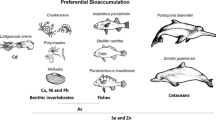Abstract
The concentration of organochlorine pesticides in pink salmon Oncorhynchus gorbusha and chum salmon O. keta has been studied for the fish sampled in the Sea of Okhotsk and along the Pacific coast of the Kuril Islands during the spawning migrations. Chum salmon accumulates much more pollutants (180 ng/g of wet weight) than pink salmon does (70 ng/g of wet weight). The total bulk of the toxicants transported by the Pacific salmon to the Russian coast of the northwestern Pacific Ocean in 2008–2010 ranged between 13.0–35.5 kg in regard to the number of the breeders reached the spawning grounds. The ecological risk for the local spawning grounds is discussed.
Similar content being viewed by others
References
Cederholm, C.J., Kunz, M.D., Murota, T., and Sibatanim, A., Pacific salmon carcasses: essential contributions of nutrients and energy for aquatic and terrestrial ecosystems, Fisheries, 1999, vol. 24, pp. 6–15.
Choy, C.A. and Drazen, J.C., Plastic for dinner? Observation of frequent debris ingestion by pelagic predatory fishes from the central North Pacific, Mar. Ecol.: Progr. Ser., 2013, vol. 485, pp. 155–153.
Derraik, J.G.B., The pollution of the marine environment by plastic debris: a review, Mar. Pollut. Bull., 2002, vol. 44, pp. 842–852.
Ewald, G., Larsson, P., Linge, H., et al., Biotransport of organic pollutants to an Inland Alaska Lake by migrating sockeye salmon (Oncorhynchus nerka), Arctic, 1998, vol. 51, no. 1, pp. 40–47.
Fedorov, L.A. and Yblokov, A.V., Psetitsidy - toksicheskii udar po biosfere i cheloveku (Pesticides are Toxic Impact on Biosphere and a Man), Moscow: Nauka, 1999.
Helfield, J.M. and Naiman, R.J., Effects of salmon-derived nitrogen on riparian forest growth and implications for stream productivity, Ecology, 2001, vol. 82, pp. 2403–2409.
Klisenko, M.A., Mel’tser, F.R., Novikova, K.F., et al., Metody opredeleniya mikrokolichestv pestitsidov v produktakh pitaniya, kormakh i vneshnei srede (Methods of Determination of Microconcentrations of Pesticides in Food, Fodders, and Environment), Moscow: Kolos, 1983.
Klovach, N.V., Pacific salmons are the wonderful gift of nature, in Mater. I nauch. shkoly “Aktual’nye voprosy ratsional’nogo ispol’zovaniya vodnykh biologicheskikh resursov” (Proc. I Sci. School “Relevant Problems of Rational Use of Aquatic Biological Resources”), Moscow: VNIRO, 2013, pp. 175–189.
Krummel, E.M., Macdonald, R.W., Kimpe, L.E., et al., Delivery of pollutants by spawning salmon, Nature, 2003, vol. 425, pp. 255–256.
Moore, C., Moore, S.L., Leecaster, M.K., and Weisberg, S.B., A comparison of plastic and plankton in the North Pacific Central Gyre, Mar. Pollut. Bull., 2001, vol. 42, pp. 1297–1300.
Rovinskii, F.Ya., Voronova, L.D., Afanas’ev, M.I., et al., Fonovyi monitoring zagryazneniya ekosistem sushi khlororganicheskimi soedineniyami (Background Monitoring of Pollution of Terrestrial Ecosystems by Chlorine-Containing Organic Compounds), Leningrad: Gidrometeoizdat, 1990.
Shuntov, V.P. and Temnykh, O.S., Tikhookeanskie lososi v morskikh i okeanicheskikh ekosistemakh (Pacific Salmons in Marine and Ocean Ecosystems), Vladivostok: TINRO-Tsentr, 2008, vol. 1.
Shuntov, V.P. and Temnykh, O.S., Tikhookeanskie lososi v morskikh i okeanicheskikh ekosistemakh (Pacific Salmons in Marine and Ocean Ecosystems), Vladivostok: TINRO-Tsentr, 2011, vol. 2.
Tanabe, S., Contamination by persistent toxic substances in the Asia-Pacific region, Dev. Environ. Sci., 2007, vol. 7, pp. 773–817.
Tomida, M., Miyazaki, N., and Kaeriyama, M., Biotransport of POPs by salmonids in the North Pacific, in Symp. “PICES-2009,” Abstracts of Papers, Jeju, Republic of Korea: PICES, 2009, p. 15.
Veldhoen, N., Ikonomou, M., Dubetzb, C., et al., Gene expression profiling and environmental contaminant assessment of migrating Pacific salmon in the Fraser River watershed of British Columbia, Aquat. Toxicol., 2010, vol. 97, pp. 212–225.
Wania, F. and Mackay, D., Tracking the distribution of persistent organic pollutants, Environ. Sci. Technol., 1996, vol. 30, pp. 390A–396A.
Wong, M.H., Armour, M.-A., Naidu, R., and Man, M., Persistent toxic substances: sources, fates and effects, Rev. Environ. Health., 2012, vol. 27, no. 4, pp. 207–213.
Author information
Authors and Affiliations
Corresponding author
Additional information
Original Russian Text © O.N. Lukyanova, V.Yu. Tsygankov, M.D. Boyarova, N.K. Khristoforova, 2015, published in Voprosy Ikhtiologii, 2015, Vol. 55, No. 3, pp. 351–355.
Rights and permissions
About this article
Cite this article
Lukyanova, O.N., Tsygankov, V.Y., Boyarova, M.D. et al. Pacific salmon as a vector in the trasnsfer of persistent organic pollutants in the Ocean. J. Ichthyol. 55, 425–429 (2015). https://doi.org/10.1134/S0032945215030078
Received:
Published:
Issue Date:
DOI: https://doi.org/10.1134/S0032945215030078




